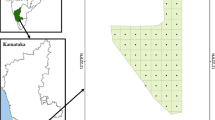Abstract
This paper discusses a new methodology to estimate soil moisture in agriculture region using SAR data with the use of HH and HV polarization. In this study the semi empirical model derived by Dubois et al. (IEEE Transactions on Geoscience and Remote Sensing, 33(4), 915–926, 1995) was modified to work using σ HH instead of two like polarization equations σHH, σVV so that soil moisture can be obtained for the larger area frequently. The field derived roughness correlated with the cross polarization ratio (HV/HH) to replace the one unknown parameter ‘s’ in the Dubois model and hence the dielectric constant was derived by inverting the Dubois model equation (HH). The Topp et al. (Water Resources Research, 16(3), 574–582, 1980) model was used to retrieve soil moisture using the dielectric constant. The mid incidence angle was used to overcome the incident angle effect and it worked successfully to the larger extent. The result is realistic overall, especially where surface has less variation in the roughness and vegetation since the penetration capability of C-band is limited when plant grows hence model valid in the initial period of cultivation. The derived model is having good scope for soil moisture monitoring with the present availability of Indian RISAT data.







Similar content being viewed by others
References
Baghdadi, N., & Zribi, M. (2006). Evaluation of radar backscatter models IEM, OH and Dubois using experimental observations. International Journal of Remote Sensing, 27(18), 3831–3852.
Baghdadi, N., Saba, E., Aubert, M., Zribi, M., & Baup, F. (2011). Evaluation of radar backscattering models IEM, Oh, and Dubois for SAR data in X-band over bare soils. IEEE Geoscience and Remote Sensing Letters, 8(6), 1160–1164.
Beaudoin, A., Le Toan, T., Goze, S., Nezry, E., Lopes, A., Mougin, E., & Shin, R. T. (1994). Retrieval of forest biomass from SAR data. International Journal of Remote Sensing, 15(14), 2777–2796.
Borgeaud, M., Attema, E., Salgado-gispert, G., Bellini, A. & Noll, J., (1995). Analysis of bare soil surface roughness parameter with ERS-1 SAR data. Symposium on the Extraction of Bio and Geophysical Parameters from SAR Data for Land Applications (pp. 307–316). Toulouse.
Brown, R.J., Pokier, S., & Manore, M.J., (1988). Correlations between X, C and L-band imagery within an agricultural environment. In Proceedings of the IEEE International Geoscience and Remote Sensing Symposium (IGARSS '88) (pp. 1279–1280). Scotland, UK: Edinburgh.
Chen, K. S., Yen, S. K., & Huang, W. P. (1995). A simple model for retrieving bare soil moisture from radar-scattering coefficients. Remote Sensing of Environment, 54(2), 121–126.
Dubois, P. C., Van Zyl, J., & Engman, T. (1995). Measuring soil moisture with imaging radars. IEEE Transactions on Geoscience and Remote Sensing, 33(4), 915–926.
Ji, J., van der Keur, P., Thomsen, A., & Skriver, H., (1996). Soil moisture retrieval using the Danish L- & C-band polarimetric SAR. In Proceedings of the IEEE International Geoscience and Remote sensing symposium (IGARSS’96) (vol. 2, pp.1300-1302) Lincoln, NB, USA..
Kasischke, E. S., Tanase, M. A., Bourgeau-Chavez, L. L., & Borr, M. (2011). Soil moisture limitations on monitoring boreal forest regrowth using spaceborne L-band SAR data. Remote Sensing of Environment, 115(1), 227–232.
Merzouki, A., McNairn, H., & Pacheco, A. (2010). Evaluation of the Dubois, Oh, and IEM radar backscatter models over agricultural fields using C-band RADARSAT-2 SAR image data. Canadian Journal of Remote Sensing, 36(S2), 274–286.
Neusch, T., & Sties, M. (1999). Application of the Dubois-model using experimental synthetic aperture radar data for the determination of soil moisture and surface roughness. ISPRS Journal of Photogrammetry and Remote Sensing, 54(4), 273–278.
Oh, Y., Sarabandi, K., & Ulaby, F. T. (1992). An empirical model and an inversion technique for radar scattering from bare soil surfaces. IEEE Transactions on Geoscience and Remote Sensing, 30(2), 370–381.
Sahebi, M. R., & Angles, J. (2010). An inversion method based on multi-angular approaches for estimating bare soil surface parameters from RADARSAT-1. Hydrology and Earth System Sciences, 14(11), 2355–2366.
Sikdar, M., & Cumming, I. (2004, September). A modified empirical model for soil moisture estimation in vegetated areas using SAR data. In Geoscience and Remote Sensing Symposium, 2004. IGARSS'04. Proceedings. 2004 IEEE International (vol. 2, pp. 803–806).
Song, K., Zhou, X., & Fan, Y. (2010). Retrieval of soil moisture content from microwave backscattering using a modified IEM model. Progress In Electromagnetics Research B, 26, 383–399.
Srivastava, H. S., Patel, P., & Navalgund, R. R. (2006). How far SAR has fulfilled its expectation for soil moisture retrieval. In Asia-Pacific Remote Sensing Symposium (pp. 641001–641001). International Society for Optics and Photonics.
Srivastava, H. S., Patel, P., Navalgund, R. R., & Sharma, Y. (2008). Retrieval of surface roughness using multi-polarized envisat-1 ASAR data. Geocarto International, 23(1), 67–77.
Topp, G. C., Davis, J. L., & Annan, A. P. (1980). Electromagnetic determination of soil water content: measurements in coaxial transmission lines. Water Resources Research, 16(3), 574–582.
Ulaby, F. T., Batlivala, P. P., & Dobson, M. C. (1978). Microwave backscatter dependence on surface roughness, soil moisture, and soil texture: part I-bare soil. IEEE Transactions on Geoscience Electronics, 16(4), 286–295.
Zribi, M., Baghdadi, N., Holah, N., & Fafin, O. (2005). New methodology for soil surface moisture estimation and its application to ENVISAT-ASAR multi-incidence data inversion. Remote Sensing of Environment, 96(3), 485–496.
Acknowledgments
This work was performed under RISAT Utilization Project funded by Indian Space Research Organization (ISRO). The authors want to thank The Director NRSC, Project Director ‘RISAT UP’ for their support throughout the project.
Author information
Authors and Affiliations
Corresponding author
About this article
Cite this article
Srinivasa Rao, S., Dinesh kumar, S., Das, S.N. et al. Modified Dubois Model for Estimating Soil Moisture with Dual Polarized SAR Data. J Indian Soc Remote Sens 41, 865–872 (2013). https://doi.org/10.1007/s12524-013-0274-3
Received:
Accepted:
Published:
Issue Date:
DOI: https://doi.org/10.1007/s12524-013-0274-3




